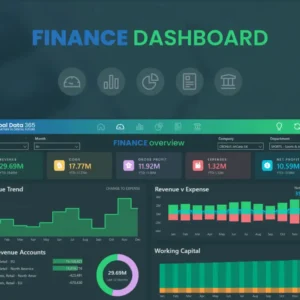Healthcare is a critical sector where efficient resource allocation directly impacts patient care and outcomes. With the influx of data in healthcare, making informed decisions about resource allocation can be overwhelming. Power BI, a robust business intelligence tool, comes to the forefront in addressing this challenge. In this blog post, we’ll delve into how Power BI can transform resource allocation in healthcare, enhancing operational efficiency and ultimately improving patient experiences.
The Imperative of Efficient Resource Allocation in Healthcare
Resource allocation in healthcare involves distributing limited resources such as staff, equipment, and finances optimally to meet patient needs. Efficient allocation ensures that resources are utilized effectively, minimizing wastage and improving the overall healthcare system’s functionality.
Why Power BI for Healthcare Resource Allocation?
Power BI is an ideal tool for healthcare resource allocation due to several key factors:
- Data Integration: Power BI seamlessly integrates with various data sources, consolidating disparate data into a unified dashboard for comprehensive analysis.
- Real-time Insights: Healthcare decisions require real-time data. Power BI offers real-time analytics, enabling quick and informed decisions for efficient resource allocation.
- Advanced Analytics: Power BI provides powerful analytics tools, such as predictive modeling and forecasting, enabling proactive resource planning and allocation.
- Interactive Dashboards: The interactive and customizable dashboards in Power BI allow healthcare professionals to visualize data, making it easier to identify resource allocation needs.
Applications of Power BI in Healthcare Resource Allocation
Power BI has a range of applications in optimizing resource allocation within the healthcare sector:
- Personnel Allocation: Analyze data to determine the optimal number of staff required in different departments based on patient flow, allowing for better personnel allocation.
- Equipment Management: Utilize Power BI to track the usage and maintenance needs of medical equipment, aiding in efficient equipment allocation and maintenance planning.
- Budget Planning: Analyze financial data to plan budgets effectively, ensuring that funds are allocated to areas that need them the most for enhanced patient care.
- Bed Capacity Management: Monitor bed occupancy rates and patient admissions to allocate beds efficiently, avoiding overcrowding and enhancing patient experiences.
Implementing Power BI for Healthcare Resource Allocation
To effectively implement Power BI for healthcare resource allocation:
- Data Preparation: Gather and prepare healthcare data, ensuring it is clean, structured, and ready for analysis.
- Define Metrics: Identify key metrics for resource allocation, such as patient admissions, staff availability, or equipment usage.
- Data Analysis: Utilize Power BI to analyze the data, deriving actionable insights for optimal resource allocation.
- Dashboard Creation: Develop interactive dashboards displaying crucial metrics and insights, aiding in informed resource allocation decisions.
Challenges and Future Trends
Challenges in healthcare resource allocation include data privacy and security, integration complexities, and ensuring data accuracy. Looking forward, AI and machine learning integration within Power BI are anticipated to further enhance predictive analytics for resource allocation.
Conclusion
Power BI empowers the healthcare industry to optimize resource allocation, ensuring that vital resources are utilized efficiently to enhance patient care. By leveraging its data integration, analytics, and visualization capabilities, healthcare professionals can make data-driven decisions that significantly impact resource allocation and, ultimately, patient outcomes. Explore the transformative potential of Power BI and take a step towards a more efficient and patient-centric healthcare system.







